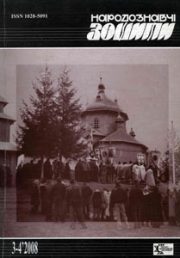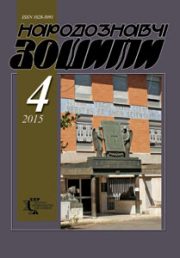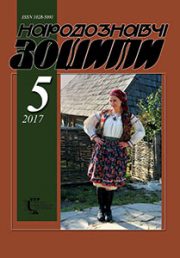The Ethnology Notebooks. 2022. № 2 (164), 365—376
UDK 94(477.83/.86)”193/194″:929
DOI https://doi.org/10.15407/nz2022.02.365
BODNAR Halyna
- ORCID: http://orcid.org/0000-0002-7972-8111
- Candidate of History, Associate Professor,
- Ivan Franko National University of Lviv,
- Mykhailo Hrushevsky Chair of Contemporary History of Ukraine
- 1, Universytetska Str., 79000, Lviv, Ukraine,
- Contacts: e-mail: halyna.bod@gmail.com
Abstract. Introduction. Oral history always pertains to emotions. Moreover, the narration of a life story itself is always an emotional experience. Biographical narratives are individual thoughts about past experiences with a special focus on senses and feelings. Scholars are becoming increasingly interested in the study of the emotional component of oral records. Emotion, unlike, irresistible impulse, for instance, can be analyzed. The empirical basis of the research are 40 interviews recorded as part of the project «Social Anthropology of Filling the Void: Poland and Ukraine after the World War II». The interviews were recorded by an interdisciplinary group of Polish-Ukrainian female researchers in 2017—2019 with residents of villages and towns of Ternopil, Lviv, and Ivano-Frankivsk oblasts born in the 1920s—1930s.
Problem Statement. The article analyzes oral stories of Eastern Halychyna residents about the complicated memory of the process and (not)filling of the «social void» — the war, vanished ethnic communities, ethnic discord, and Soviet repressions against the backdrop of the 1930s — 1940s epoch in general and everyday stories, personal stories in particular. Purpose. How do the elderly remember their experiences — how do they tell of what they have seen / heard, how do they explain it; how do they describe the traumatic experience?
Methods. The study is based on the interdisciplinary cultural and anthropological approach to the study of memory, methodology of oral history research, first of all methods of narrative analysis and content analysis.
Results. Oral stories collected within the project are one of the few opportunities not missed to compile a corpus of sources about the history of the 1930s — 1940s and Eastern Halychyna in particular. The stories of people born in the 1920s have a particularly intricate plot; these are stories of young people who could(not) make a choice. Yet, a vast majority of the respondents were born in the 1930s, thus, their testimony describes not only personal childhood trauma — being orphaned, working hard, lost opportunities of getting an education and social growth, unsuccessful personal life – but also contains eyewitness stories of the Holocaust, which serve as the emotional climax for those infrequent biographical narratives, which describe it.
Conclusion. Research proven ability to recall the emotions in traumatic experiences, the study of relatively stable long-term emotions (reflecting and moral) and the memory formed under their influence, the creation of a therapeutic situation during an interview via careful listening and empathy, i.e. articulating things yet unheard – are part of the increased problematics of oral history which awaits further, more profound research.
Keywords: oral historical narratives, сhildren’s everyday life experiences, emotions, trauma, silence, Eastern Halychyna, the 1930s—1940s.
Received 12.04.2022
REFERENCES
- Bornat, J. (2010). Remembering and Reworking Emotions: the Reanalysis of Emotion in an Interview. Oral History, 38 (2), 43—52.
- Harding, J. (2014). Looking for Trouble: Exploring Emotion, Memory and Public Sociology: Inaugural Lecture, 1 May 2014, London Metropolitan University. Oral History, 42 (2), 94—104.
- Reddy W.M. (2001). The Navigation of Feeling: A Framework for the History of Emotions. New York: Cambridge University Press.
- Holmes, K. (2017). Does It Matter If She Cried? Recording Emotion and the Australian Generations Oral History Project. Oral History Review, 44 (1), 56—76. Retrieved from: file:///C:/Users/HP/Downloads/Does_it_matter_if_she_cried_Recording_Em.pdf (Last accessed: 1.07.2020).
- Rolph, S., & Atkinson, D. (2010). Emotion in Narrating the History of Learning Disability. Oral History, 38 (2), 53—63.
- Campbell, R. (2018). «We Were Basically Counselors»: The Unintended Emotional Duties of «Donut Dollies» in the Vietnam War. Words and Silences (Oral History and Emotions), 1—19. Retrieved from: https://www.ioha.org/wp-content/uploads/2018/03/01_Campbell_IOHA_English.pdf (Last accessed: 1.07.2020).
- Hamilton, C. (2008). On Being a «Good» Interviewer: Empathy, Ethics and the Politics of Oral History. Oral History, 36 (2), 35—43.
- Blee, K. (1998). Evidence, Empathy and Ethics: Lessons from Oral Histories of the Klan. In R. Perks and A. Thomson (Eds.). The Oral History Reader (Pp. 333—343). London; New York: Routledge.
- Holmes, K. (2017). Learning to Read Emotions in Oral History. OUPblogs. Retrieved from: https://blog.oup.com/2017/05/oral-history-emotions/ (Last accessed: 2.07.2020).
- BenEzer, G. (1999). Trauma Signals in Life Stories. In K.L. Rogers, S. Leydesdorf and G. Dawson (Eds.). Trauma and Life Stories: International Perspective (Pp. 29—44). London: Routledge.
- Truong, K.P., Westerhof, G.J., Lamers, S.M.A., & de Jong, (Eds.). (2013). Emotional Expression in Oral History Narratives: Comparing Results of Automated Verbal and Nonverbal Analyses. OUPblogs. Retrieved from: https://core.ac.uk/download/pdf/62917942.pdf (Last accessed: 2.07.2020).
- Grinchenko, G. (2004). Textual analysis of oral historical evidence (for example oral interviews with former «Ostarbeiters» of Kharkiv region). Skhid-Zakhid: Istoryko-kul’turolohichnyj zbirnyk (Issue 6, pp. 151—170). Kharkiv; Kyiv: Krytyka [in Ukrainian].
- Portelli, А., & Loskutova, M.V. (Ed.). (2003). Features of oral history. In M.V. Loskutova. Khrestomatiya po ustnoy istorii (Pp. 32—51). Sankt-Peterburg: izd-vo EUSPb [in Russian].
- Jones, D.W. (1998). Distressing Histories and Unhappy Interviewing. Oral History, 24 (2), 49—56.
- Hamilton, C. (2010). Moving Feelings: Nationalism, Feminism and the Emotions of Politics. Oral History, 38 (2), 85—94.
- Jasper, J.M. (2011). Emotions and Social Movements: Twenty Years of Theory and Research. Annual Review of Sociology, 37, 285—303.






